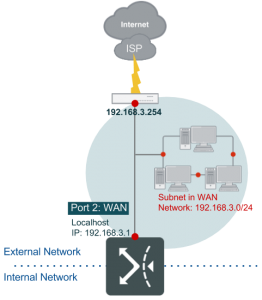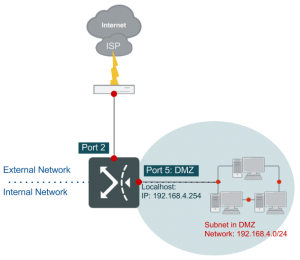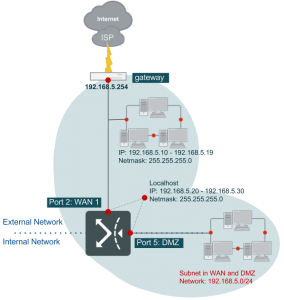WAN/DMZ Private Subnet
After having gone through public subnet configurations, let’s move to private subnet settings. This section lists a few typical topology structures for private subnet. Similarly, FortiWAN supports two different types of private subnet according to the deployment, direct or indirect connecting to FortiWAN.The two settings are configured from [Basic Subnet] and [Static Routing Subnet]. FortiWAN supports both IPv4 and IPv6 for the two private subnet types.
On its UI, [IPv4 Basic Subnet] and [IPv6 Basic Subnet] could be one of:
- Subnet in WAN l Subnet in DMZ l Subnet in WAN and DMZ
- Subnet on Localhost (Not support in [IPv6 Basci Subnet])
And [IPv4 Static Routing Subnet] and [IPv6 Static Routing Subnet] could be one of:
- Subnet in WAN l Subnet in DMZ
[Basic Subnet]: Subnet in WAN
This topology is frequently found where cluster hosts in the IPv4 private subnet are located on the WAN. In this example, FortiWAN port2 has been mapped to WAN port, with IP 192.168.3.1. Select [Subnet in WAN] from [Subnet Type] in [Basic Subnet]. Then enter 192.168.3.1 in [IP(s) on Localhost] and the netmask offered by ISP in [Netmask].
Note: FortiWAN assumes that IP addresses that are unlisted in [IP(s) on Localhost] are all in WAN.
[Basic Subnet]: Subnet in DMZ
This topology is frequently found where cluster hosts in IPv4 private subnet are located on the DMZ. In this example, FortiWAN port5 has been mapped to DMZ port, with private IP 192.168.4.254. And subnet 192.168.4.X is located on the DMZ as a whole. From UI, select [Subnet in DMZ] from [Subnet Type] in [Basic Subnet].
Check [Enable DHCP] if hosts in the subnet in DMZ require DHCP service. And enter the starting and ending address in [DHCP Range]. If any host in the subnet uses static IP address, then in [Static Mapping], enter its IP and MAC address. Note: FortiWAN assumes IP addresses that are unlisted in [IP(s) on Localhost] are all in DMZ. Thus there is no need to configure them.
[Basic Subnet]: Subnet in WAN and DMZ
This topology is found where cluster hosts in IPv4 private subnet are located in both WAN and DMZ. FortiWAN hereby assumes IP addresses that are unlisted in [IP(s) on Localhost] and [IP(s) in WAN] are all in the DMZ. Port2 and port5 are connected in dotted line, indicating the subnet spreads across WAN (port2) and DMZ (port5). FortiWAN employs Proxy ARP to connet the whole subnet togther. In this example, more than one IP addresses are needed for FortiWAN in bridging. These IP addresses therefore have to be on the same network segment.
Enter 192.168.5.20-192.168.5.30 in [IP(s) on Localhost], and 192.168.5.10-192.168.5.19 in [IP(s) in WAN].
[Basic Subnet]: Subnet on Localhost
This topology is found where a whole IPv4 private subnet is designated on FortiWAN. And the IP addresses in this subnet can be utilized by Virtual Server. An IPv6 private subnet is not supported for this subnet type.



